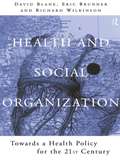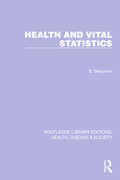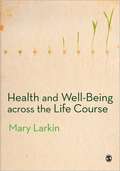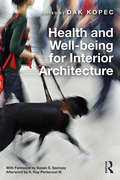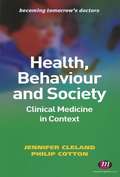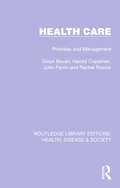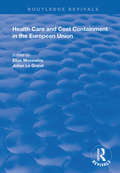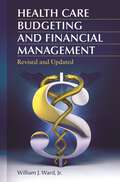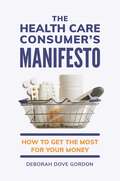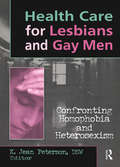- Table View
- List View
Health and Social Organization: Towards a Health Policy for the 21st Century
by David Blane Eric Brunner Richard WilkinsonThere is widespread recognition that the most powerful determinants of health today are to be found in social, economic and cultural circumstances. These include: ecnomic growth, income distribution, consumption, work oganisation, unemployment and job insecurity, social and family structure, education and deprivation, and they are all aspects of 'social organisation'. In ^Health and Social Organisation leading British and North American researchers who bring together an invaluable collection of data on these issues, draw from the social sciences, epidemiology and biology.
Health and the National Health Service (Contemporary Issues in Public Policy)
by John Carrier Ian KendallThe NHS came into existence in an atmosphere of conflict centred on the strong ideological commitment of the Post-war Labour Government and the opposition of the Conservative Party of that time to the idea of a universally available and centrally planned medical care service. There was also opposition from some sections of the medical establishment who feared the loss of professional autonomy. Setting health policy in both an historical and modern context (post 1997) Carrier and Kendall weigh up the successes and failures of the National Health Service and examine the conflicts which have continued for over sixty years, in spite of efforts to solve financial problems in the NHS through increases in funding as well as structural and organisational change. After looking at recent responses to supposed failures of the NHS, they conclude that the NHS has successfully faced the challenges before it and is likely to continue to meet the changing health needs of the population. Financial stresses, concerns about the quality of care and demographic change, with consequent issues for the elderly and the chronically ill, continue to be urgent and politically contentious issues. This book is appropriate for a wide range of undergraduate and postgraduate students studying health policy and the NHS.
Health and the National Health Service (Contemporary Issues in Public Policy)
by John Carrier Ian KendallThe NHS came into existence in an atmosphere of conflict centred on the strong ideological commitment of the Post-war Labour Government and the opposition of the Conservative Party of that time to the idea of a universally available and centrally planned medical care service. There was also opposition from some sections of the medical establishment who feared the loss of professional autonomy. Setting health policy in both an historical and modern context (post 1997) Carrier and Kendall weigh up the successes and failures of the National Health Service and examine the conflicts which have continued for over sixty years, in spite of efforts to solve financial problems in the NHS through increases in funding as well as structural and organisational change. After looking at recent responses to supposed failures of the NHS, they conclude that the NHS has successfully faced the challenges before it and is likely to continue to meet the changing health needs of the population. Financial stresses, concerns about the quality of care and demographic change, with consequent issues for the elderly and the chronically ill, continue to be urgent and politically contentious issues. This book is appropriate for a wide range of undergraduate and postgraduate students studying health policy and the NHS.
Health and Vital Statistics (Routledge Library Editions: Health, Disease and Society #3)
by Bernard BenjaminOriginally published in 1968, this book was intended to help those in health and welfare services as well as those whose policy decisions are influenced by the movement of statistical indices of health, to understand the purpose, derivation and meaning of these indices. It teaches by presenting statistical problems as they are encountered in practice against the background of day-to-day administrative procedures to which they relate. Special attention is paid to practices in the USA and to considerations of international comparability.
Health and Vital Statistics (Routledge Library Editions: Health, Disease and Society #3)
by Bernard BenjaminOriginally published in 1968, this book was intended to help those in health and welfare services as well as those whose policy decisions are influenced by the movement of statistical indices of health, to understand the purpose, derivation and meaning of these indices. It teaches by presenting statistical problems as they are encountered in practice against the background of day-to-day administrative procedures to which they relate. Special attention is paid to practices in the USA and to considerations of international comparability.
Health And Well-being Across The Life Course
by Mary LarkinUsing a life course approach, the main chapters in this truly original and enlightening text focus on health and well-being during each of our life stages. A wide range of contemporary literature from disciplines such as public health, sociology, epidemiology and social policy are drawn upon to examine key health and well-being issues in these stages, and to illustrate how health effects can accumulate across the life course. Interactive activities based on the text and on extracts from primary sources are used to encourage critical reflection and debate. Mary Larkin's book will be essential reading for students on the many courses that need an understanding of health and well-being across all age groups. It will also be an invaluable resource for those in the health and social care sector as well as practitioners working in the field.
Health and Well-being for Interior Architecture
by Dak KopecWinner of the 2018 IDEC Book Award With fifteen essays by scholars and professionals, from fields such as policy and law, Health and Well-being for Interior Architecture asks readers to consider climate, geography, and culture alongside human biology, psychology, and sociology. Since designers play such a pivotal role in human interaction with interior and architectural design, this book sheds light on the importance of a designer’s attention to health and well-being while also acknowledging the ever changing built environment. Through various viewpoints, and over 30 images, this book guides designers through ways to create and develop interior designs in order to improve occupants’ health and well-being.
Health and Well-being for Interior Architecture
by Dak KopecWinner of the 2018 IDEC Book Award With fifteen essays by scholars and professionals, from fields such as policy and law, Health and Well-being for Interior Architecture asks readers to consider climate, geography, and culture alongside human biology, psychology, and sociology. Since designers play such a pivotal role in human interaction with interior and architectural design, this book sheds light on the importance of a designer’s attention to health and well-being while also acknowledging the ever changing built environment. Through various viewpoints, and over 30 images, this book guides designers through ways to create and develop interior designs in order to improve occupants’ health and well-being.
Health And Wellbeing: PSHE In Scotland (PDF) (Curriculum For Excellence Ser. (PDF))
by Marel Harper Gail Whitnall Lesley Meza Stephen SilvaThe Health and Wellbeing, PHSE in Scotland series offers a comprehensive active learning resource that covers all Level 3 Experiences and Outcomes for Health and Wellbeing in Curriculum for Excellence. Appropriate for use by specialist and non-specialist teachers alike, these books provide an invaluable aid in the practicalities of Getting it Right for Every Child (GIRFEC). Health and Wellbeing 1 lays the foundation of the course and, through a wide variety of classroom-friendly activities and stimulus material, introduces the S1 pupil to key Organisers across the Health and Wellbeing framework: Planning for choices and changes; Relationships; and Mental, emotional, social and physical wellbeing.
Health And Wellbeing 2: Pshe In Scotland (Curriculum For Excellence Ser.)
by Marel Harper Gail Whitnall Lesley Meza Stephen Silva Julie BallThe Health and Wellbeing, PHSE in Scotland series offers a comprehensive active learning resource that covers all Level 3 Experiences and Outcomes for Health and Wellbeing in Curriculum for Excellence. Appropriate for use by specialist and non-specialist teachers alike, these books provide an invaluable aid in the practicalities of Getting it Right for Every Child (GIRFEC). Health and Wellbeing 2 progressively builds on the S1 material and, through a wide variety of classroom-friendly activities and stimulus material, introduces the S2 pupil to key Organisers across the Health and Wellbeing framework: Planning for choices and changes; Relationships; and Mental, emotional, social and physical wellbeing.
Health and Wellness in Antiquity through the Middle Ages (Health and Wellness in Daily Life)
by William H. YorkEarly medical practices are not just a historical curiosity, but real stories about people and health that may teach us much about the 21st century. This intriguing volume offers a comparative examination of early medicine and health care in regions as varied as ancient Mesopotamia, Egypt, Greece, Rome, India, China, the Islamic world, and medieval Europe.Health and Wellness in Antiquity through the Middle Ages compares and contrasts health-care practices in seven different cultures from around the world. In considering the range of medical practitioners in each society, and the kinds of health care they provided, it examines the development of a written medical tradition, the methods of medical education, the practice of surgery, and the theories and practices of pharmacy. Other topics include the application of medicine in specific contexts, such as the treatment of women, children, and those with mental illness. Another important theme explored is the impact of religion and state institutions on the development, implementation, and results of medical care as experienced by real people in real life. Throughout, the book offers an international historical perspective, which allows for greater comparative and critical understanding of how different cultural beliefs influenced the development and management of health care.
Health and Wellness in Antiquity through the Middle Ages (Health and Wellness in Daily Life)
by William H. YorkEarly medical practices are not just a historical curiosity, but real stories about people and health that may teach us much about the 21st century. This intriguing volume offers a comparative examination of early medicine and health care in regions as varied as ancient Mesopotamia, Egypt, Greece, Rome, India, China, the Islamic world, and medieval Europe.Health and Wellness in Antiquity through the Middle Ages compares and contrasts health-care practices in seven different cultures from around the world. In considering the range of medical practitioners in each society, and the kinds of health care they provided, it examines the development of a written medical tradition, the methods of medical education, the practice of surgery, and the theories and practices of pharmacy. Other topics include the application of medicine in specific contexts, such as the treatment of women, children, and those with mental illness. Another important theme explored is the impact of religion and state institutions on the development, implementation, and results of medical care as experienced by real people in real life. Throughout, the book offers an international historical perspective, which allows for greater comparative and critical understanding of how different cultural beliefs influenced the development and management of health care.
Health, Behaviour and Society: Clinical Medicine in Context (PDF)
by Philip Cotton Jennifer ClelandThere is more to a person than a particular symptom or disease: patients are individuals but they are not isolated, they are part of a family, a community, an environment, and all these factors can affect in many different ways how they manage health and illness. This book provides an introduction to population, sociological and psychological influences on health and delivery of healthcare in the UK and will equip today's medical students with the knowledge required to be properly prepared for clinical practice in accordance with the outcomes of Tomorrow's Doctors.
Health Benefits of Green Tea: An Evidence-based Approach
by R Agnihotri Z Apostolides T Asakawa Z. M. Chen S Gaur Yukihiko Hara M Inai Mamoru Isemura T Kakuda T Kan M. J. Lee Z Lin M Maeda-Yamamoto S Masuda S Meguro T Minami N Miyoshi M Monobe H Moriwaki Y Nakamura O Numata K Saeki K Sayama Y Shimamura M Shimizu T Suzuki H Tachibana P. W. Taylor I Tokimitsu Isao Tomita T. A. Tomita K Unno H Wang H Yamada C. S. Yang H YokogoshiThis book provides evidence to support the health-promoting components of green tea for human health. It explores the significance of green tea and its catechins represented by epigallocatechin gallate (EGCG), demonstrating their beneficial effects on diseases including cancer, obesity, arteriosclerosis, diabetes, hepatitis, and neurodegenerative diseases. The present status of human studies and avenues for future research are discussed. It is written by a team of experts from across the globe and makes significant Japanese findings available to international researchers. It is an essential resource for researchers interested in the biochemistry and pharmacology of green tea, and functional foods and beverages.
Health Care: Priorities and Management (Routledge Library Editions: Health, Disease and Society #4)
by Gwyn Bevan Harold Copeman John Perrin Rachel RosserOriginally published in 1980, this book explores how the NHS confronts perennial stresses and problems, considering in particular the allocation of the scarce resources within the health service. Written by distinguished academics, three of whom previously undertook research work for the Royal Commission on the NHS, the discussion centres on whether more could not be spent, whether resources are being allocated equitably, how planning can work most effectively, whether there are feasible ways of financing the service and how organisation and management could be improved: in short, all issues which continue to be pertinent to the NHS today.
Health Care: Priorities and Management (Routledge Library Editions: Health, Disease and Society #4)
by Gwyn Bevan Harold Copeman John Perrin Rachel RosserOriginally published in 1980, this book explores how the NHS confronts perennial stresses and problems, considering in particular the allocation of the scarce resources within the health service. Written by distinguished academics, three of whom previously undertook research work for the Royal Commission on the NHS, the discussion centres on whether more could not be spent, whether resources are being allocated equitably, how planning can work most effectively, whether there are feasible ways of financing the service and how organisation and management could be improved: in short, all issues which continue to be pertinent to the NHS today.
Health Care and Cost Containment in the European Union (Routledge Revivals)
by Elias Mossialos Julian Le GrandFirst published in 1999, this volume aims to describe and analyse the experience of cost containment in Europe over the last fifteen years in order to understand that experience and to determine, as best we can, which methods were successful and which were not. Part I provides an overview of healthcare in the European Union, an overview of recent expenditure trends. Part II complements the first, examining in detail cost containment policies in each EU Member State. The country-based chapters refer to developments up to mid-1997.
Health Care and Cost Containment in the European Union (Routledge Revivals)
by Elias Mossialos Julian Le GrandFirst published in 1999, this volume aims to describe and analyse the experience of cost containment in Europe over the last fifteen years in order to understand that experience and to determine, as best we can, which methods were successful and which were not. Part I provides an overview of healthcare in the European Union, an overview of recent expenditure trends. Part II complements the first, examining in detail cost containment policies in each EU Member State. The country-based chapters refer to developments up to mid-1997.
Health Care and the Autism Spectrum: A Guide for Health Professionals, Parents and Carers (PDF)
by Alison Morton-Cooper'You'll just feel a little scratch then it will all be over.' This well-worn phrase to reassure patients about injections is unlikely to win over the patient if they happen to have autism. Communication difficulties, sensory overload and extreme discomfort with physical contact are all traits common in autism that make basic patient care and routine medical procedures extremely difficult. In a patient who is exquisitely sensitive to touch, how do you go about taking blood pressure or dressing a wound? How can you be sure that your autistic patient has given `informed' consent to treatment if you aren't sure that they have really understood the implications? What do you do about it? Equally, for people with autism, or the parent or carer of someone on the spectrum, healthcare issues loom very large in daily concerns. Health Care and the Autism Spectrum is a ground-breaking volume that addresses the ethical issues as well as the practical challenges that everyone involved has to deal with. Every health care professional will have an increasing number of autistic patients on their list as diagnosis of this condition continues to spiral. Consequently, this book is urgently needed.
Health Care Budgeting and Financial Management
by William J. Jr.In today's chaotic health reform environment, it is especially important for non-financial health care managers to have a practical guide to the tools and concepts they need to manage their human, supply, and equipment resources.Today's health care managers, frequently, were yesterday's technicians, physicians, and nurses. This puts them in an interesting predicament, since they know the health care side of the business but often lack the financial management skills necessary to create budgets and manage finances in a health care setting. In this guide, William J. Ward Jr. offers easy-to-understand explanations of basic accounting concepts, including cash flow, operating cost and cost behavior, revenue and reimbursement, and so much more.Providing clearly presented financial information in the context of health care, Ward's book is a one-stop desk reference that provides practical, useful tools and knowledge that readers can immediately put to use. It will help managers, directors, and clinical leaders who work in hospitals, physician practices, and other provider organizations to effectively manage their financial resources on a day-to-day basis, providing guidance for essential tasks such as preparing budgets, managing their departments, and making decisions around financial issues.
Health Care Budgeting and Financial Management
by William J. Jr.In today's chaotic health reform environment, it is especially important for non-financial health care managers to have a practical guide to the tools and concepts they need to manage their human, supply, and equipment resources.Today's health care managers, frequently, were yesterday's technicians, physicians, and nurses. This puts them in an interesting predicament, since they know the health care side of the business but often lack the financial management skills necessary to create budgets and manage finances in a health care setting. In this guide, William J. Ward Jr. offers easy-to-understand explanations of basic accounting concepts, including cash flow, operating cost and cost behavior, revenue and reimbursement, and so much more.Providing clearly presented financial information in the context of health care, Ward's book is a one-stop desk reference that provides practical, useful tools and knowledge that readers can immediately put to use. It will help managers, directors, and clinical leaders who work in hospitals, physician practices, and other provider organizations to effectively manage their financial resources on a day-to-day basis, providing guidance for essential tasks such as preparing budgets, managing their departments, and making decisions around financial issues.
The Health Care Consumer's Manifesto: How to Get the Most for Your Money
by Deborah Dove GordonA health care executive at Harvard explains how to become a savvy consumer and get the value we all deserve for our health care spending.This book navigates and demystifies the confusing world of health care shopping. Readers go on a guided tour inside American health care to learn why it is so messy, and who is invested in keeping it that way. The text offers a new vision of how health care could work if it were truly designed to meet consumer needs, creating a call to action on how to demand and help create such a system. A wake-up call to an industry tenuously holding on to the status quo and ripe for true disruption, this book outlines what consumers can do themselves and demand from doctors, hospitals, health plans, and policy makers to get more for their health care spending and, in so doing, reshape the health care system into one we all deserve. Using real and compelling consumer stories intertwined with expert analysis, this book illustrates why it is so difficult to act as an engaged health care consumer in the United States and pulls back the curtain to expose the forces that hold the system in place.
The Health Care Consumer's Manifesto: How to Get the Most for Your Money
by Deborah Dove GordonA health care executive at Harvard explains how to become a savvy consumer and get the value we all deserve for our health care spending.This book navigates and demystifies the confusing world of health care shopping. Readers go on a guided tour inside American health care to learn why it is so messy, and who is invested in keeping it that way. The text offers a new vision of how health care could work if it were truly designed to meet consumer needs, creating a call to action on how to demand and help create such a system. A wake-up call to an industry tenuously holding on to the status quo and ripe for true disruption, this book outlines what consumers can do themselves and demand from doctors, hospitals, health plans, and policy makers to get more for their health care spending and, in so doing, reshape the health care system into one we all deserve. Using real and compelling consumer stories intertwined with expert analysis, this book illustrates why it is so difficult to act as an engaged health care consumer in the United States and pulls back the curtain to expose the forces that hold the system in place.
Health Care Finance: Economic Incentives and Productivity Enhancement
by Steven R. EastaughThis book is a thorough, balanced, and insightful study of what is happening and what should be happening in health care financing. Americans want unlimited access to the best care at affordable prices. Fiscal pressures in American health care point in all different directions, like a pile of jackstraws. This important book analyzes how new payment incentives stimulate planned competition or reregulation; and the far-reaching impact these changes have on hospitals, physicians, long-term care facilities, HMOs, public health clinics, and multihospital systems. Tools for survival include better financial planning, productivity improvement, better scheduling systems, and total quality management.Steven R. Eastaugh begins his book with a general overview of cost management, accounting, product-line selection, and new payment incentives. Part II provides an in-depth survey of fiscal trends in long-term care, managed care, HMOs, and PPOs. Part III analyzes five basic strategies that a provider may consider; with special focus on market analysis, diversification, and pricing. The next part reviews physician payment options, the new Medicare 1992 payment systems for hospitals and physicians, and cost analysis of hospital patient care, research, and education. Part V considers productivity enhancement methods, incentives to assist productivity programs, and the Deming method of total quality management. Part VI focuses on investment, financing, and capital structure decisions in health care institutions and also in large multifacility systems. The last part summarizes major strategies for success in the 1990s, future policy alternatives, and suggests a number of alternative roads to universal entitlement and national health care reform. As Eastaugh suggests in this book, Our health system faces . . . immense opportunity and danger in a reformation on four fronts: access, efficiency, effectiveness, and quality of life. The challenge for providers and managers during this period of unparalleled opportunity is to win a clear victory on all four fronts, and not erode either access or quality in the name of efficiency. The range of coverage in Health Care Finance is extremely wide and detailed--making it essential and useful reading for health care professionals and students alike.
Health Care for Lesbians and Gay Men: Confronting Homophobia and Heterosexism
by K Jean PetersonHealth Care for Lesbians and Gay Men educates practitioners about the special needs of gay and lesbian patients and how to look critically at the impact of homophobia and heterosexism on the provision of care. It provides an overview of critical health care issues for lesbians and gay men and offers concrete suggestions to health practitioners and social workers on how to address these issues in order to guarantee the best care for their patients and clients. Authors in Health Care for Lesbians and Gay Men give health care providers and mental health workers practical interventions; suggestions for advocacy, social change, grassroots efforts, and alternative programs; and lessons about how to use existing procedures to more effectively meet the unique health care needs of gays and lesbians. Practitioners also learn how to utilize legal action in securing and protecting patients’and clients’personal health care wishes. Chapters in this book cover: how homophobia and negative attitudes can directly compromise the care given to lesbians and gay men. heterosexism and biases which exclude the partners of gay men and lesbians from participating in the care of their loved ones. legal issues and the need for legal recognition of gay and lesbian relationships, both to enhance the provision of care and for financial access to health care presently available to only heterosexual, married couples. legal protection and special legal documents that ensure that the wishes of gay men and lesbians are honored and the integrity of their relationships not violated.Health Care for Lesbians and Gay Men starts with special issues confronting adolescents and the special role health care providers can play in supporting the struggles of lesbian and gay adolescents. It then continues to look at these issues over the life cycle. Three themes emerge as authors try to explain problems and possible solutions for lesbians and gay men seeking health care: the pervasive homophobia and heterosexism found throughout the health care system and the impact these attitudes and beliefs have on the health care of lesbians and gay men; the need for education in professional programs on special health issues of gay men and lesbians; and the critical role that social workers can play in both educating others about the special needs of their gay and lesbian clients and in advocating for their clients in various health care settings.Health Care for Lesbians and Gay Men is essential reading for social work and social service practitioners and students working in the health care field, advanced undergraduates and graduate students of social work, professionals and students of nursing and medicine, and others concerned with the quality and equality of health care services. It urges students and professionals to challenge and evaluate their own attitudes, beliefs, and behaviors in order to ensure quality services to all clients and patients.
